[K12配套]2018年春七年级英语下册Unit6OutdoorfunTask导学案新版牛津版
【K12学习】七年级英语下Unit6OutdoorfunReading教案(新版牛津版)
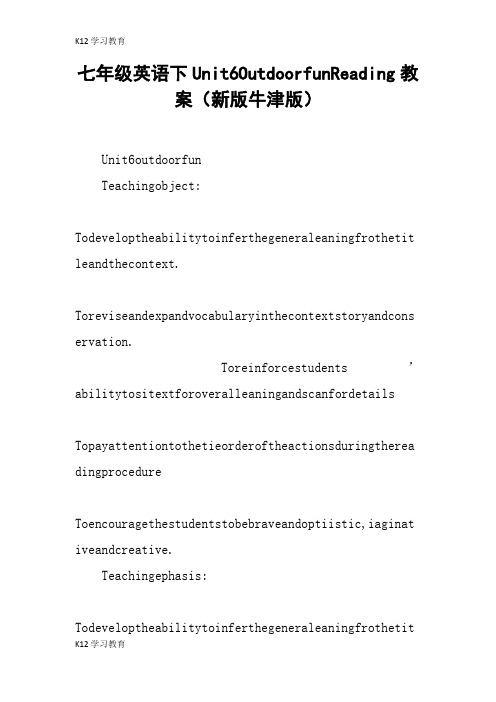
七年级英语下Unit6OutdoorfunReading教案(新版牛津版)Unit6outdoorfunTeachingobject:Todeveloptheabilitytoinferthegeneraleaningfrothetit leandthecontext.Toreviseandexpandvocabularyinthecontextstoryandcons ervation.Toreinforcestudents’abilitytositextforoveralleaningandscanfordetailsTopayattentiontothetieorderoftheactionsduringtherea dingprocedureToencouragethestudentstobebraveandoptiistic,iaginat iveandcreative.Teachingephasis: Todeveloptheabilitytoinferthegeneraleaningfrothetitleandthecontext.Teachingdifficulties:Toreinforcestudents’abilitytositextforoveralleaningandscanfordetails Teachingprocedure:Step1.Pre-readingar-upGoodorning,boysandgirls.Areyoureadyfortheclass?Ihop eecanhaveapleasanttietogether.Doyouthinso?It’sasunnyday,right?Noit’sspring.Ithinspringisagreattieforoutdooractivities, youno,beingoutside,enjoyingthesunshineandthefreshai r,nearthebeautifullaesandhills,that’sgreat.hatoutdooractivitiesdoyoulie?hatdoyoulieabou tit?teachsoeneordsandphrasesyounoyfavoriteoutdooractivities?Iliejoggingintheorn ing.It’sgoodforourhealth.Thisorning,Ienthoeafterjoggingasu sual.Ipushedthedoor,butitdidn’tove.Thedoorasloced.SoIneedaey.Iputyhandintoypocett ofindit.Butitasn’tthere.Thereasnothingbutabigholeinypocet.Ididn’tnoticethat.Theeyandyobilephoneustgothroughit.Ilost the.hatcanIdo?Lucily,Isaoneofyneighborspassingby.So Iasedhiforhelptocallyhusband.Then,atlastIgotinandth angod,Iasn’tlateforthisclass.Looattheseords,I’sureyoucanreadtheloudly,right?introduceoutdooractivitiesarefun,butit’sapitythatedon’thaveuchtieforit.earesobusy.Butecanstillreadstories oratchoviesaboutit.Today,eilllearnanexcitingstoryto gether.Doyounothenaeofthestory?adventure:anexciting journey,onderland,aorldfullofonders.canyoutellussoe thingaboutit?Hereisaposter.AliceisalovelyEnglishgir l.Shehasalotofideas.Sheentintoaonderland..Inthisfan tasyorld,anialscantal,driningcanaeyourbodybeesaller andsaller,eatingapieceofcaecanaeyougrobiggeratonce, allthethingsarestrangehere.Aliceetalotofpeopleandan ials.Thehiterabbit---inacoat,ithaatchThebluecaterpillar-----hosoesapipeonaushrooThecheshirecat-----alaysearsaverybigsileThehatter-----theanithahatThearchhare-----adasaarchhareThequeenofhearts------Step2.hile-readingSiingTheyarestrange,right.Doyouanttotaealooatthisonderla nd?Nolet’sbeginouradventureithAlice.openyourboos,turntopage7 0,readitquiclytoseehathappened.Findtheanserstothese questionsquicly.Iillgiveyou2inutes.ScanningAfterreading,ourfriendSionadesoenotesonp72.Let’schecthenotesforhi,TorF,youshouldreadthenotesfirst, thenthestory,payattentiontothedetails.Findhichlinet herightansersarein.ill3inutesbeenough?close-reading⑴.readpara1&2carefully,andanserthreequestions.youc andiscussingroupsifnecessaty.IfyouereAlice,hatillyoudohenyouseesuchastrangeanial?hatdidAlicedo?Let’scontinuereading.⑵.readpara3,puttheactionsintotherightorder.Harearesoeactions,buttheyareintherongorder.Let’sreadpara3andputtheintherightorder.ecanseethathentellingstoriesecanusetheorderoftie.Taeturnstoretellthestory.⑶Thenhat’sinthehole?hathappenednext?Let’satchashortvideo,hodidAlicefeelinthelonghole?hatdid shesee?Didshegetoutofthehall?Fillintheblansaccordingtopara4-5Step3.Post-readingGrouporSupposeAliceasn’taloneinthehall,shefoundtoofherfriendstheretoo.orin agroupofthree,aeaconversation.youcantalliethis…hey,Alice.…...Assoepairstotalinfrontoftheclass.asuarhathappenednext?DidAlicegettothelovelygarden?younoy oucansurelyhaveyourondreas,youcandecidehereitgoesfr ohere.Solistentoyourheart,althoughdistantdreasareno treal,ourheartsaretrue,ifereallyant,nothingillstopu s.Sojustbeyourself.eepyouriaginationandcreativity.B ecause……Step4.HoeorAfterclass,Iouldlieyoutosearchfororeinfo rationaboutthestory.教后感:。
春七年级英语下册 Unit 6 Outdoor fun课时内容精讲课时作业 (新版)牛津版-(新版)
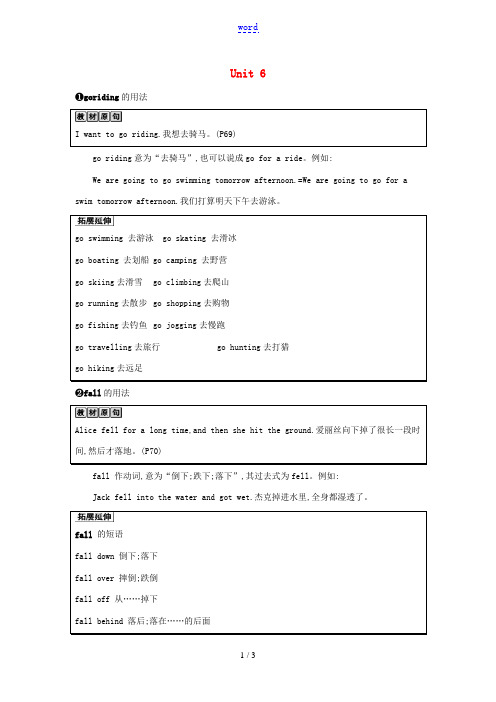
Unit 6❶goriding的用法go riding意为“去骑马”,也可以说成go for a ride。
例如:We are going to go swimming tomorrow afternoon.=We are going to go for a swim tomorrow afternoon.我们打算明天下午去游泳。
❷fall的用法fall 作动词,意为“倒下;跌下;落下”,其过去式为fell。
例如:Jack fell into the water and got wet.杰克掉进水里,全身都湿透了。
❸alone的用法1.alone作形容词,意为“单独的”,只作表语。
例如:Robinson was alone on the island.罗宾逊一人在岛上。
2.alone作副词,意为“单独地;独自”。
例如:The old woman lived alone in the mountain village.这位老妇独自一人住在那个山村里。
❹practise的用法1.practise作动词,意为“练习;实践”,后接名词、代词或动名词。
例如:Practise these dialogues.练习这些对话。
We should practise speaking English every day.我们应该每天训练说英语。
2.practice为practise的名词形式,意为“练习;训练”。
在美式英语中practice也是动词形式。
例如:Practice makes perfect.[谚]熟能生巧。
❺put的用法1.put作动词,意为“放;置”。
例如:Please put your shoes under the bed.请把鞋放在床下。
2.put up 意为“举起;建起;住宿”。
例如:Those who want to see the film put up your hands.想看电影的人,请举手。
教育最新K12七年级英语下册 Unit 6 Outdoor fun study skills教案 (新版)牛津版
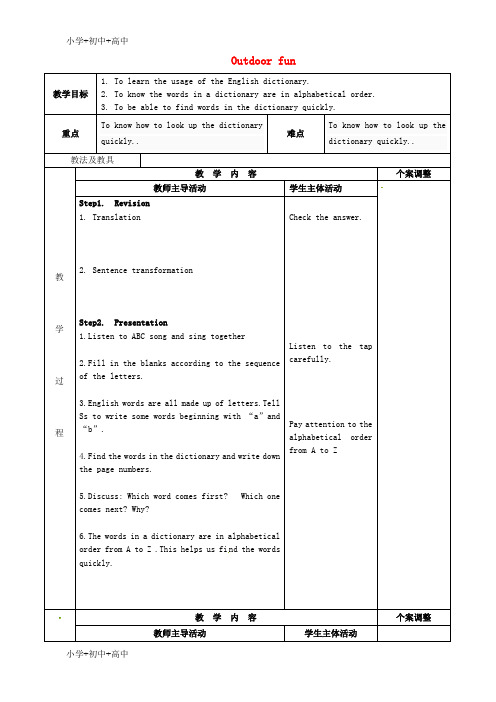
程
教 学 教师主导活动 小学+初中+高中
内
容 学生主体活动
个案调整
小学+初中+高中 Look at the words on the blackboard .Because “a”comes before “b” in alphabetical order, all the words beginning with “a”comes before the words beginning with “b”.in a dicti onary. 7. Disscuss: 教 1).If two words start with the same letter,what should we do ? 2).If the first two letters are t he same, what should we do ? 学 3).If the first three letters are the same, what should we do Step3. Production 1.Put the words in Part A1 in alphabetical order 过 and write down the numbers 1-8 in the blanks. Finish the blanks 2.Have a competition.(Who ca n find the words in the dictionary fastest?) 程 3.Now let’s learn how to use the guide words.Look at Part B .On the left are some page numbers and guide words from a dictionary.Write down the page numbers for the words on the right. Step 4. Homework 1. Review the contents of this lesso n. 2. Do the Exercises of the workbook. and check the answer. Work in pairs to make a conversation.
牛津译林版英语七年级下册《Unit 6 Outdoor fun Integrated skills》

牛津译林版英语七年级下册《Unit 6 Outdoor fun Integrated skills》教学设计1一. 教材分析牛津译林版英语七年级下册《Unit 6 Outdoor fun Integrated skills》主要围绕着户外活动展开,通过描述不同户外活动的图片和句子,让学生能够听、说、读、写与户外活动相关的词汇和句子。
此单元的关键在于让学生能够运用所学的知识,进行简单的实际操作和表演。
二. 学情分析七年级的学生已经掌握了一些基本的英语语法和词汇,对于图片的识别和理解能力也较强。
但是,他们在语言表达和听力理解方面还有待提高。
因此,在教学过程中,需要注重培养学生的语言表达能力和听力理解能力。
三. 教学目标1.能够听懂、会说、会读、会写与户外活动相关的词汇和句子。
2.能够通过图片和文字,理解户外活动的内容和意义。
3.能够运用所学的知识,进行简单的实际操作和表演。
四. 教学重难点1.重点:户外活动相关词汇的掌握和运用。
2.难点:对于听力材料的理解和实际操作能力的培养。
五. 教学方法采用交际法、任务型教学法和情境教学法,让学生在实际情境中,通过听、说、读、写的实际操作,掌握和运用所学知识。
六. 教学准备1.教学PPT2.录音机和录音带3.图片和实物七. 教学过程1.导入(5分钟)通过展示一些户外活动的图片,如游泳、打篮球等,引导学生谈论他们喜欢的户外活动。
2.呈现(10分钟)呈现本节课的主要内容,即与户外活动相关的词汇和句子。
通过图片和实物,让学生听、说、读、写这些词汇和句子。
3.操练(10分钟)将学生分成小组,让他们通过角色扮演的方式,运用所学的词汇和句子进行对话。
教师巡回指导,纠正学生的错误。
4.巩固(5分钟)让学生听一段与户外活动相关的录音,要求他们根据所听到的内容,完成相关的问题。
5.拓展(5分钟)让学生设计一个户外活动,包括活动名称、地点、时间、内容等,并用英语进行描述。
6.小结(5分钟)教师对本节课所学内容进行小结,强调重点词汇和句子的运用。
最新七年级英语下册 Unit 6 Outdoor fun全单元教案 (新版)牛津版
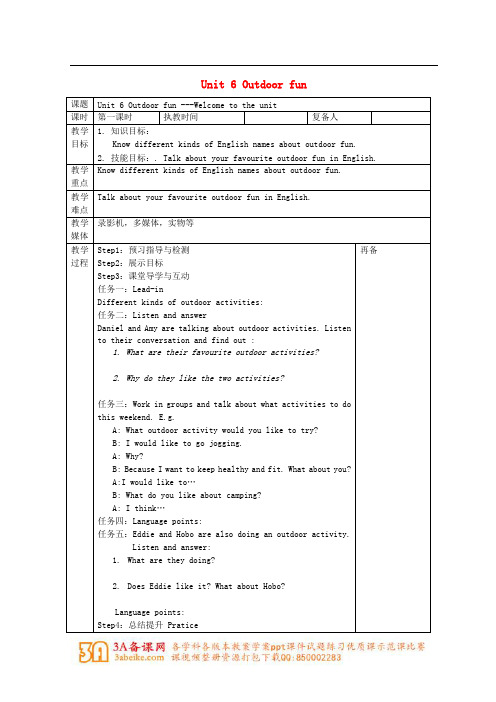
Unit 6 Outdoor fun课题Unit 6 Outdoor fun ---Welcome to the unit课时第一课时执教时间复备人教学目标1. 知识目标:Know different kinds of English names about outdoor fun.2. 技能目标:. Talk about your favourite outdoor fun in English.教学重点Know different kinds of English names about outdoor fun.教学难点Talk about your favourite outdoor fun in English.教学媒体录影机,多媒体,实物等教学过程Step1:预习指导与检测Step2:展示目标Step3:课堂导学与互动任务一:Lead-inDifferent kinds of outdoor activities:任务二:Listen and answerDaniel and Amy are talking about outdoor activities. Listento their conversation and find out :1. What are their favourite outdoor activities?2. Why do they like the two activities?任务三:Work in groups and talk about what activities to dothis weekend. E.g.A: What outdoor activity would you like to try?B: I would like to go jogging.A: Why?B: Because I want to keep healthy and fit. What about you?A:I would like to…B: What do you like about camping?A: I think…任务四:Language points:任务五:Eddie and Hobo are also doing an outdoor activity.Listen and answer:1.What are they doing?2.Does Eddie like it? What about Hobo?Language points:Step4:总结提升 Pratice再备Step5:当堂反馈Step6:课后拓展Step7:布置作业1.Copy new words and phrases.2.Recite the dialogue教学反思课题Unit 6 Outdoor fun ---Reading 1课时第二课时执教时间复备人教学目标1. 知识目标:1. Master the new words and phrases.2. Learn something about the story by using different kinds of reading skills.3. Pay attention to the order of narrating a story.2. 技能目标:Learn about the simple past tense.教学重点Learn something about the story by using different kinds of reading skills.教学难点Pay attention to the order of narrating a story.教学媒体录影机,多媒体,实物等教学过程Step1:预习指导与检测Step2:展示目标Step3:课堂导学与互动任务一:Lead-in1. Do you read this book or watch the movie?2. Show some pictures one by one. Talk about the story.任务二:Listen and answerWhat did Alice do one sunny day?2. Who did Alice run after?3. What could Alice see on the other side when the small door opened?4. Did Alice go through the small door?任务三:Complete Part B1,B2 on Page 71 and B3 on Page 72.任务四:Watch a video and Retell the story between Alice andthe rabbit.任务五:Complete Part B4 on Page 72.Fill in the passage about the story.Step4:总结提升归纳重点短语和句型Step5:当堂反馈Step6:课后拓展Step7:布置作业1.Copy new words and phrases.2.Recite the dialogue再备教学反思课题Unit 6 Outdoor fun ---Reading 2课时第三课时执教时间复备人教学目标1. 知识目标:1. Master the new words and phrases.2. Learn something about the story by using different kinds of reading skills.3. Pay attention to the order of narrating a story.2. 技能目标:Learn about the simple past tense.教学重点Learn something about the story by using different kinds of reading skills.教学难点Pay attention to the order of narrating a story.教学媒体录影机,多媒体,实物等教学过程Step1:预习指导与检测Step2:展示目标Step3:课堂导学与互动任务一:复习课文Talk about the story between Alice and a rabbit任务二:Work with your group members and try to answer these questions:1. What did Alice see?2. What surprised Alice?3. Where did Alice find herself?4. Was it a key for any of the doors?5. Why Alice did not go through the door?任务三:Interview Have students prepare some questionsin groups first, then each group can suggest one to be the interviewer and interview other students任务四:Language points任务五:practiceStep4:总结提升_____________________________________________________Step5:当堂反馈Step6:课后拓展Step7:布置作业1.Copy new words and phrases.2.Recite the dialogue再备教学反思课题Unit 6 Outdoor fun ---Grammar课时第四课时执教时间复备人教学目标1. 知识目标:1. Master the new words and phrases.2. Learn to use the simple past tense.2. 技能目标:Learn to use the simple past tense correctly.3. 情感目标:Learn to use the simple past tense to describe what happened to us in the past..教学重点Learn to use the simple past tense.教学难点Learn to use the simple past tense.教学媒体录影机,多媒体,实物等教学过程Step1:预习指导与检测Step2:展示目标Step3:课堂导学与互动任务一: Lead-inShow the students a picture and ask the students to work out therule of the simple past tense.动词过去式的构成任务二:Practice 见课件1.We always (go) to Shanghai when I was achild.2. They (not go) to school last Wednesday,they (have) a match.3. Mike (drive) to Nanjing three days ago, he (not, take) a train there.4. She seldom (arrive) home late after work,but she (come) back at 10p.m. yesterday.任务三:Finish Page 74 Part A,B.Step4:总结提升Step5:当堂反馈Step6:课后拓展Step7:布置作业1.Copy new words and phrases.2.Recite the dialogue再备教学反思课题Unit 6 Outdoor fun --- Integrated skills 课时第五课时执教时间复备人教学目标1.知识目标:学习单词: wood, period, century, excited, mobile phone dynasty ,Italian,province,学习词组:make a bird out of wood, use bamboo to make kites, century, become famous for, from then on学习句子:It’s dangerous to swim in the lake. Now everything is ready. Shall we go?2. 技能目标:能通过听力材料获取有关风筝的信息。
2018年春七年级英语下册Unit6OutdoorfunIntegratedskillsStudys
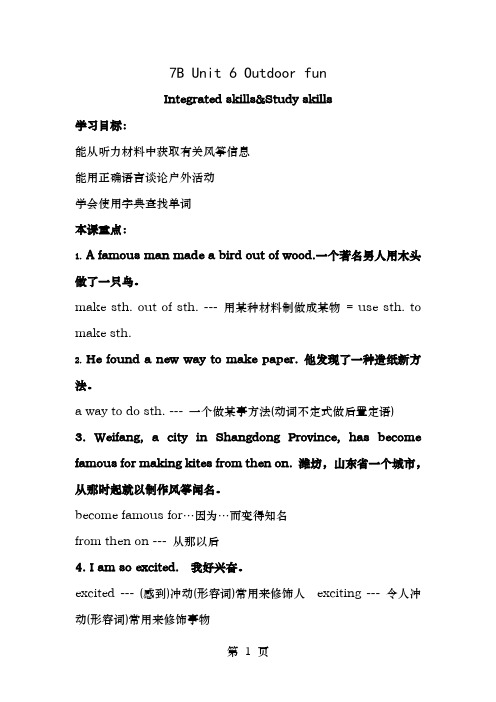
7B Unit 6 Outdoor funIntegrated skills&Study skills学习目标:能从听力材料中获取有关风筝信息能用正确语言谈论户外活动学会使用字典查找单词本课重点:1.A famous man made a bird out of wood.一个著名男人用木头做了一只鸟。
make sth. out of sth. --- 用某种材料制做成某物= use sth. to make sth.2.He found a new way to make paper. 他发现了一种造纸新方法。
a way to do sth. --- 一个做某事方法(动词不定式做后置定语)3. Weifang, a city in Shangdong Province, has become famous for making kites from then on. 潍坊,山东省一个城市,从那时起就以制作风筝闻名。
become famous for…因为…而变得知名from then on --- 从那以后4. I am so excited. 我好兴奋。
excited --- (感到)冲动(形容词)常用来修饰人exciting --- 令人冲动(形容词)常用来修饰事物5.It's dangerous to swim in the lake. 在湖里游泳很危险。
It's + 形容词+ (for sb) + to do sth. --- (对某人来说)做某事是...6.Remember to take your mobile phone. 记得带上你手机。
remember to do sth. --- 记得去干某事(事情还没做)remember doing sth. --- 记得干过某事(事情已做)7. Marco Polo told people in the West all about kites.马可波罗告诉西方所有人关于风筝事。
教育最新K12七年级英语下册 Unit 6 Outdoor fun welcome to the Unit教案 (新版)牛津版
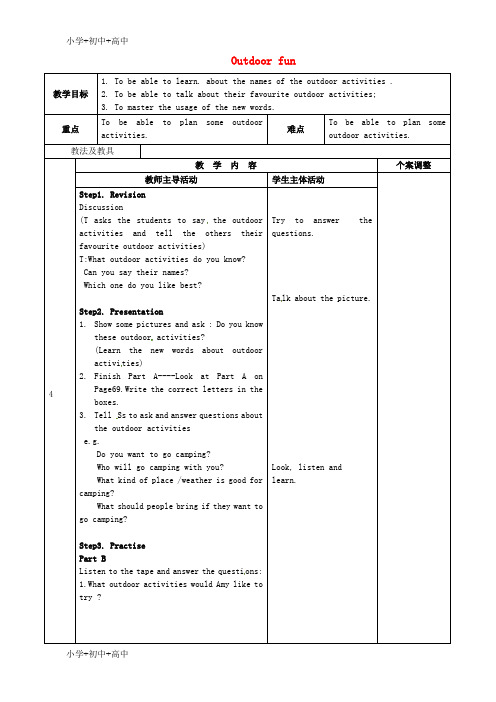
重点
教法及教具
Try to answer questions.
the
Ta lk about the picture.
4
Look, listen and learn.
小学+初中+高中
小学+初中+高中
教 学 教师主导活动
内
容 学生主体活动 Ask and answer. Listen and retell.
小学+初中+高中
Outdoor fun
教学目标 1. To be able to learn. about the names of the outdoor activities . 2. To be able to talk about their favourite outdoor activities; 3. To master the usage of the new words. To be able to plan some outdoor activities. 教 教师主导活动 Step1. Revision Discussion (T asks the students to say the outdoor activities and tell the others their favourite outdoor activities) T:What outdoor activities do you know? Can you say their names? Which one do you like best? Step2. Presentation 1. Show some pictures and ask : Do you know these outdoor activities? (Learn the new words about outdoor activi ties) 2. Finish Part A----Look at Part A on Page69.Write the correct letters in the boxes. 3. Tell Ss to ask and answer questions about the outdoor activities e.g. Do you want to go camping? Who will go camping with you? What kind of place /weather is good for camping? What should people bring if they want to go camping? Step3. Practise Part B Listen to the tape and answer the questi ons: 1.What outdoor activities would Amy like to try ? 学 内 容 学生主体活动 难点 To be able to plan some outdoor activities. 个案调整
[配套K12]2016-2017学年七年级英语下册 Unit 6 Outdoor fun Task教
![[配套K12]2016-2017学年七年级英语下册 Unit 6 Outdoor fun Task教](https://img.taocdn.com/s3/m/0c7bebf1da38376baf1fae5d.png)
Outdoor fun教学目标:1. 能条理清晰的描述事情。
2. 能熟练运用本单元所学知识进行续写。
教学重点: 能条理清晰的描述事情教学设计:Step 1 Review1. 将学生引入本课时的语言环境:Alice in Wonderland is a famous story . We read a part of it in Reading .Do you like it ?Do you think it’s exciting ?What do you think will happen to Alice ?鼓励学生根据自己的知识回答,也可发挥自己的想象。
2. 接着对学生说:You have so many good ideas . They’re all very exciting .I’ll tell you what actually happens to Alice.Step II Presentation1. 让学生将书翻到课本第78页并说:This is the next part of the story . Read it and tell me :What did Alice see on the table ?布置学生阅读并回答:She saw a little bottle on the table .2. 让学生再次阅读并回答教师事先提出的问题:(1)Did Alice drink the juice in the bottle ?(2)How did she feel ?(3)What happened to her after she drank it ?(4)What did she decide to do then ?(5)What did she forget ?(6)Could she reach the table ?(7)What did she see under the table ?指导学生根据A部分的内容回答问题并教授新知识,板书become, enter, forget, decide, reach ,fail ,和feel a little ill, too........to,帮助学生理解d. Alice failed to climb up the tablee. Alice saw a little bottle on the tablef. Alice opened the bottle and drank a little.g. Alice became smaller and smallerStep III 准备1. 引导学生:Alice found a note under the table near the cake .What did the note say ? 学生回答:It said “EAT ME’2. 接着问学生:What will Alice do next? Why?鼓励学生发表自己的观点。
七年级英语下册 Unit 6 Outdoor fun Task课件 (新版)
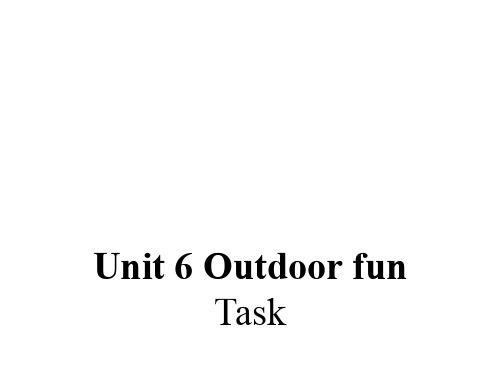
2. She drank a little and then felt a little ill. (T)
3. After she drank it, her body became
sbmigaglelerranadndbigsgmear.ller ( F)
Paras 3-4and answer:
• What did Alice see on the table? She saw a little bottle on it.
• Did Alice become smaller? Yes, she did.
Paras 1-2
True or False:
1. Alice diddnr’tadnrkink the water in the bottle.( F)
Adverbs:
sadly, happily, quickly, slowly, carefully …
Make your writing vivid (生动的).
How to use conjunctions
Alice opened the bottle and drank a little. It tasted sweet. Alice liked it. She drank some more. Then she felt a little ill. She looked down and saw that her body became smaller and smaller.
No. Because She was too small to reach the table.
4. What did she see under the table?
She saw a piece of cake under the table.
七年级英语下册Unit6Outdoorfun(第4-5课时)教案
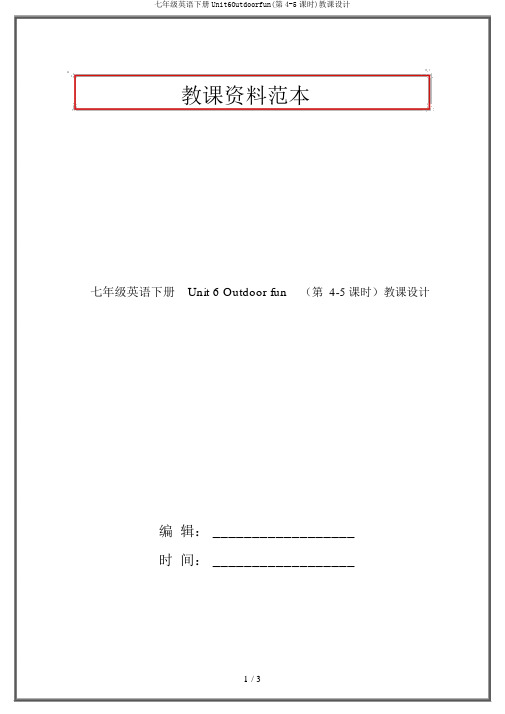
教课资料范本七年级英语下册Unit 6 Outdoor fun(第4-5课时)教课设计编辑: __________________时间: __________________Unit 6 Outdoor fun教课内容课题Unit 6 Outdoor fun第 4 、5学时教课目的1、能条理清楚地描绘事情2、能娴熟运用本单元所学知识进行续写教课重难点1、能用写故事导学过程自我空间Teaching procedures:StepⅠLead-in1. Play a video about Alice in Wonderland before class.2. Talk about magic things in wonderland.[Purpose:Arouse student s’ interest in reading the story.Inspire students’ creative thinking about wonderland]StepⅡ1. Have a revision of the reading passage.Down the rabbit holea. Present some pictures and help the students recall thereading passage of this unit.b. Get the stude nts totalk about t he storywith help of some pictures.[Purpose:makepreparations for further reading of the story]2. Read more of Alice in Wonderlanda. Go through the passage quickly and answer two questions.b. Read Para.1-2 and do some T/F statements.c. Read Para.3-4 andanswer some questions.[P urpose:get studentsto understand the meaning of the story and increase their interestin writing the following story]Step Ⅲ Writing practice1.Pre-writing.a. Present some questions.Will Alice eat thecake?What will happen to her after that?Where will she go next?What will she see?Will she meet the white rabbit again?b. Talk about the five questions. Present some picturesto inspire students ’ imagination if necessary.[Purpose: lead the students to open their mind and make preparations for writing]2. While-writingWrite about what happened to Alice next using the fivequestions. Give students some help if necessary.[Purpose: lead students to turn the ideas in mind into words onpaper and help them write creative ideas precisely]3. Post-readinga. Group work: Check each others’ writing.[ Purpose: enjoy different writings and share different ideas]Step Ⅳ Show time1. Have some students present their writings. Ask others some questions about the writings.riting /Imagination/Words and expressions)[Purpose: c heck students ’ understanding of the writings. Encourage students to tell what they like about the writings.]Step Ⅴ Summary & Homework1.Summary2.Homework.Rewrite the passage and try to make it perfect.学习反省:。
- 1、下载文档前请自行甄别文档内容的完整性,平台不提供额外的编辑、内容补充、找答案等附加服务。
- 2、"仅部分预览"的文档,不可在线预览部分如存在完整性等问题,可反馈申请退款(可完整预览的文档不适用该条件!)。
- 3、如文档侵犯您的权益,请联系客服反馈,我们会尽快为您处理(人工客服工作时间:9:00-18:30)。
7B Unit 6 Outdoor funTask学习目标:能条理清晰地描述事情能熟练运用本单元所学知识进行续写本课重点:1.Then she felt a little ill.然后她觉得有点不舒服。
a little的意思是"一点",在句子中表示肯定的含义,little和a little都是修饰不可数名词的little的意思是“很少的,几乎没有”,在句子中表示否定含义。
2.Alice had to go back to the table, but she was too small to reachthe key. 爱丽丝不得不回到桌子上,但她太小了,够不着钥匙。
too+ 形容词+to do, 表示“太……而不能……”3.Alice didn’t know what to do. 爱丽丝不知道该怎么办。
“疑问词+不定式(短语)”结构,它的作用相当于一个名词性从句,通常在某些动词(如tell, know, imagine, learn, decided, forget, remember, consider, understand等)后面做宾语,有时也用作主语、表语、同位语等。
如:He didn’t know how to answer her. 他不知道该怎样回答她。
When to start has not been decided. 何时动身尚未决定。
4. A note on the table said "DRINK ME". 桌上的一张字条上写着“喝我”。
said --- say --- 说…(强调说的内容), 此处say是习惯用法,英语中还有:信上说;书上说;通知上说……tell --- 告诉 speak --- 说话,说语言 talk (about) --- 谈论5. She looked down and saw that her body became smaller and smaller. 她低头一看,发现自己的身体越来越小。
look down --- 向下看 smaller and smaller---越来越小比较级 + and + 比较级 --- 越来越...6. Soon Alice was small enough to go through the door, so she decided to enter the garden. 很快爱丽丝就小到可以进门了,所以她决定进入花园。
形容词/副词 + enough to do sth. --- 足够...去干某事decide to do sth. --- 决定干某事enter --- 进入(动词) = go into7.When she walked towards the door, she forgot about the key. 当她走向门口时,她忘记了钥匙。
towards --- 向,朝(只表示朝某个方向,并不意味着到达) to --- 朝,向(含有到达之意)forget (about) sth.--- 忘记某事 forget doing sth. --- 忘记干过某事 forget to do sth. --- 忘记去干某事8.Alice had to go back to the table, but she was too small to reach the key. 爱丽丝不得不回到桌子上,但她太小了,够不着钥匙。
too + 形容词/副词+ to do sth. --- 太...而不能做某事 = not + 形容词/副词 + enough to do sth.课堂检测:一、根据句意及提示完成单词1. Do you want to have something to eat? Yes, but only a l_______.2. I don’t like eating s_______ food because they are bad for teeth.3. Winter comes, the weather b______ cold.4. The room is ________(足够的) big for us to live in.5. There was no food in the fridge. So we _______(决定) to buy some.6. Please knock on the door before _______(进入) the room.7. In our areas, most doors open t_______ south.8. Don’t ________(忘记) to tell him the news.9. The apple is too high for the boy to r______.10. If you f_______, don’t give up. Try it again.二、单项选择( )1. The boy is _______ short _______ the orange on the table.A.too; not to reachB. too; to reachC. enough; to reachD. to; to reach( )2. The bridge is _______ to go through.A.big enoughB. enough bigC. long enoughD. enough long( )3. I forgot ______ the door. I did it again.A.to closeB. closingC. will closeD. to closing( )4. Tom decided _______for a walk in the forestA. goB. to goC. goingD. goes( )5. When I passed the classroom, I heard a girl _______in it.A. singB. to singC. sangD. singing四、完形填空Can we make animals work for us? Some scientists think that one day we may teach animals to do a lot of simple 1 . They say that in a film or on TV we may see elephants, monkeys, dogs or 2 animals doing a lot of things. If you watch 3 , you may find that we always give those animals something to eat in return for 4 them. The scientists say that we may teach many 5 animals to do lots of simple jobs if they know they 6 something to eat in return.Of course, as we know, we can use dogs to guard(守卫) a 7 , and we can use elephants to do some 8 jobs. And we can also teach animals to work in 9 . For example, people have used apes (猿猴) to help make cars, and scientists are sure that these large monkeys may one day get in crops (收割庄稼) and even 10 trains. ( ) 1. A. jobs B. homework C. thing D. works( ) 2. A. another B. other C. others D. the others( ) 3. A. care B. careful C. carefully D. carelessly( ) 4. A. did B. do C. does D. doing( ) 5. A. difference B. different C. same D. strange( ) 6. A. get B. got C. shall get D. will get( ) 7. A. cat B. house C. man D. mouse( ) 8. A. heavy B. important C. simple D. tired( ) 9. A. factories B. museums C. shops D. theaters( ) 10. A. buy B. carry C. drive D. make五.阅读理解Mr. Reece was a farmer(农民) .He and his wife(妻子) grew a lot of things. They worked very hard. One day, Mr. Reece said to his wife, “let’s go to the city next Sunday. We can have a good lunch there, and then we’ll go to the cinema.”His wife was very happy when she heard this, because she and her husband (丈夫) always ate a lot . She didn’t like cooking three times a day.They went to the city by train the next Sunday. They walked about for an hour. When it was twelve o’clock, they wanted to have a meal. They looked at some restaurants. Out of one of them was a notice(布告), “Lunch12:30 to 2:30 , 1.5 dollars.”“Well, that’s good,” said Mr. Reece, “we can eat for two hours for 1.5 dollars here. That’s too cheap. This is the place for us.”( ) 1. Mr. Reece usually worked in____________.A. the fieldsB. the cityC. the restaurantD. the theatre( ) 2. Mr. Reece and his wife went to the city_____________.A. to have a good lunchB. to see a filmC. to do some shoppingD. A and B, maybe C, too( ) 3. When did Mr. And Mrs. Reece arrive in the city?A.At about 11:00B. At about 12:00C. At about 12:30D. At about 2:30( ) 4. We can see that Mr. Reece ________________.A.was poorB. was rich(富的)C. understood the noticeD. didn’t understand the notice( ) 5.Why did Mr. Reece say that restaurant was the place for them? Because ___________A.that was the best restaurantB.12:30 to 2:30 was the best time for lunch.C.He thought they could eat a lot and it was cheap.D.They were very tired and hungry.答案:一.1.little2.sweet3. becomes 3. enough4. decided5. entering6. towards7. forget8. reach9. reach 10.fail二. BCABD三. ABCDB DBAAD四. ADCDC。
